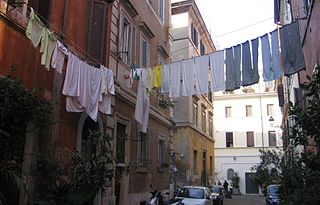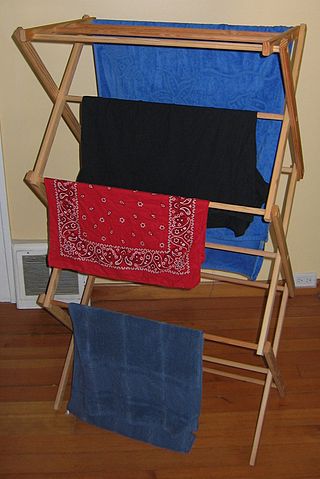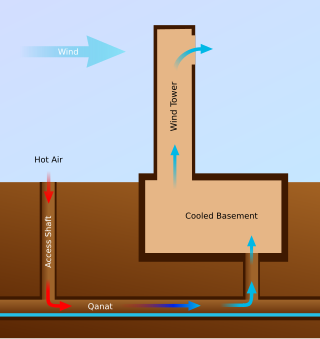
Heating, ventilation, and air conditioning (HVAC) is the use of various technologies to control the temperature, humidity, and purity of the air in an enclosed space. Its goal is to provide thermal comfort and acceptable indoor air quality. HVAC system design is a subdiscipline of mechanical engineering, based on the principles of thermodynamics, fluid mechanics, and heat transfer. "Refrigeration" is sometimes added to the field's abbreviation as HVAC&R or HVACR, or "ventilation" is dropped, as in HACR.

Laundry is the washing of clothing and other textiles, and, more broadly, their drying and ironing as well. Laundry has been part of history since humans began to wear clothes, so the methods by which different cultures have dealt with this universal human need are of interest to several branches of scholarship.

A washing machine is a machine designed to launder clothing. The term is mostly applied to machines that use water. Other ways of doing laundry include dry cleaning and ultrasonic cleaning.

A major appliance, also known as a large domestic appliance or large electric appliance or simply a large appliance, large domestic, or large electric, is a non-portable or semi-portable machine used for routine housekeeping tasks such as cooking, washing laundry, or food preservation. Such appliances are sometimes collectively known as white goods, as the products were traditionally white in colour, although a variety of colours are now available. An appliance is different from a plumbing fixture because it uses electricity or fuel.

A dehumidifier is an air conditioning device which reduces and maintains the level of humidity in the air. This is done usually for health or thermal comfort reasons or to eliminate musty odor and to prevent the growth of mildew by extracting water from the air. It can be used for household, commercial, or industrial applications. Large dehumidifiers are used in commercial buildings such as indoor ice rinks and swimming pools, as well as manufacturing plants or storage warehouses. Typical air conditioning systems combine dehumidification with cooling, by operating cooling coils below the dewpoint and draining away the water that condenses.

A clothes dryer is a powered household appliance that is used to remove moisture from a load of clothing, bedding and other textiles, usually after they are washed in the washing machine.

Ventilation is the intentional introduction of outdoor air into a space. Ventilation is mainly used to control indoor air quality by diluting and displacing indoor pollutants; it can also be used to control indoor temperature, humidity, and air motion to benefit thermal comfort, satisfaction with other aspects of the indoor environment, or other objectives.

A laundry room or utility room is a room where clothes are washed, and sometimes also dried. In a modern home, laundry rooms are often equipped with an automatic washing machine and clothes dryer, and often a large basin, called a laundry tub, for hand-washing of delicate clothing articles such as sweaters, as well as an ironing board. Laundry rooms may also include storage cabinets, countertops for folding clothes, and, space permitting, a small sewing machine.

A clothes line, also spelled clothesline, also known as a wash line, is a device for hanging clothes on for the purpose of drying or airing out the articles. It is made of any type of rope, cord, wire, or twine that has been stretched between two points, outdoors or indoors, above ground level. Clothing that has recently been washed is hung over the line to dry, held in place using clothes pegs or clothespins. Washing lines are attached either from a post or a wall, and are frequently located in back gardens, or on balconies. Longer washing lines often have props holding up the mid-section so the weight of the clothing does not pull the clothesline down to the ground.
A fabric softener or fabric conditioner is a conditioner applied to laundry after it has been washed in a washing machine. A similar, more dilute preparation meant to be applied to dry fabric is known as a wrinkle releaser.

A clothes horse is a portable frame upon which wet laundry is hung to dry by evaporation. The frame is usually made of wood, metal or plastic. It is a cheap low-tech piece of laundry equipment, as opposed to a clothes dryer, which requires electricity to operate, or a Hills Hoist, which requires ample space, wind and fine weather. It also served as an alternative to an airing cupboard. In cold, damp seasons and in the absence of central heating, a clothes horse placed by a fireside or a kitchen range provides a place to warm clothing before putting it on. The practice of airing, once ubiquitous in Great Britain, for example, in the constant battle against damp and mold, has become far less common with the advent of central heating and affordable clothes dryers.

A walk-in closet or walk-in wardrobe (UK) or dressing room is typically a large closet, wardrobe or room that is primarily intended for storing clothes, footwear etc., and being used as a changing room. As the name suggests, walk-in closets are closets sufficiently big as to allow one to walk into them to browse through the items. It is often a small room with wall-mounted cabinet, shelf and drawers, and these can either be with or without doors. Walk-in closets often do not have doors in front of shelves, which can give a better overview of the clothes, but also leads to more dust. When the walk-in closet is large enough for dressing and undressing, the wardrobe is often also equipped with one or more mirrors. The room should also have good lighting, and a bench or chair can be handy. A dressing table is sometimes also found in the walk-in closet, and such dual use can relieve congestion around other rooms such as bathrooms.

A technical room or equipment room is a room where technical equipment has been installed, for example for controlling a building's climate, electricity, water and wastewater. The equipment can include electric panels, central heating, heat network, machinery for ventilation systems, air conditioning, various types of pumps and boilers, as well as telecommunications equipment. It can serve one or more housing units or buildings.

A ground-coupled heat exchanger is an underground heat exchanger that can capture heat from and/or dissipate heat to the ground. They use the Earth's near constant subterranean temperature to warm or cool air or other fluids for residential, agricultural or industrial uses. If building air is blown through the heat exchanger for heat recovery ventilation, they are called earth tubes.

A combo washer dryer is a combination in a single cabinet of a washing machine and a clothes dryer. It should not be confused with a "stackable" combination of a separate washing machine and a separate clothes dryer.

A drying cabinet is today usually an electrical machine designed to expedite the drying of items - usually clothing - that are unsuitable for a mechanical clothes dryer. Such items may include delicate clothing care labeled as "hang dry", "dry flat" or "do not tumble dry" on their wash instructions, as well as items such as comforters, boots and coats.

A dryer ball is a spherical laundry device for tumbling clothes dryers used as an alternative to fabric softener, reducing static electricity or softening clothing, or to accelerate the drying process.

An overhead clothes airer, also known variously as a ceiling clothes airer, laundry airer, pulley airer, laundry rack, or laundry pulley, is a ceiling-mounted mechanism to dry clothes. It is also known as, in the North of England, a creel and in Scotland, a pulley.
HVAC is a major sub discipline of mechanical engineering. The goal of HVAC design is to balance indoor environmental comfort with other factors such as installation cost, ease of maintenance, and energy efficiency. The discipline of HVAC includes a large number of specialized terms and acronyms, many of which are summarized in this glossary.
A shoe dryer or boot dryer is a machine used for drying shoes, and usually functions by blowing air on the inside of the shoes. The airflow causes the shoes to dry faster. The air can be heated for even faster drying, and these are the most common types. Shoes dryers can be especially useful for people who often have wet shoes, such as families with small children or people who often hike outdoor in the nature, or for ski boots which often are moist after use. Many shoes dryers have a timer which shuts off the dryer after some time. There are also shoe dryers which instead use a heated grate which the shoes are placed on top of, and which do not blow air.




















